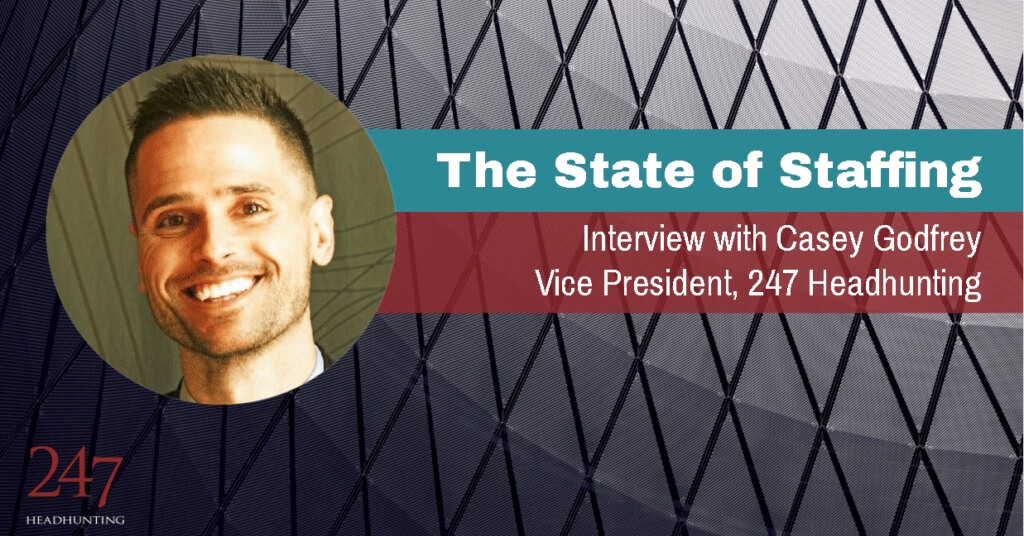We sat down with 247Hire Vice President Casey Godfrey to talk about the state of the staffing industry and the COVID-19 crisis. More specifically, we discussed some recent reports covering the staffing market, whether he’s seeing these reports reflected on the ground, as well as his predictions for the remainder of the year.
From your perspective, how does the staffing market look today compared to early March before the U.S. was significantly impacted by the Coronavirus?
CASEY GODFREY: The staffing market is much slower. Back in February and early March there was nothing but optimism. Unemployment was as low as it had ever been, and the market was extremely candidate-driven. There were more requisitions than there were people available to fill them, and companies were eyeing strong growth for the year. For everyone, the focus was on how to find enough qualified candidates to fill the open positions. That all seems so long ago now…
Now that challenge is reversed, and previously growth-minded organizations are now focused on staying afloat. End-clients have cancelled or withdrawn a lot of their roles and open positions. Today more people are looking for jobs, as opposed to in March and April. Many of the hiring freezes from earlier in the year remain, but I’m encouraged to see these start to lessen. So from the staffing firm perspective, it’s a matter of being strategic and finding the right opportunity, which means bringing in requisitions that are actually fillable.
So you’re starting to see those hiring freezes go away then?
CG: Slightly, yes. From our standpoint the market has steadily improved over the past several weeks, particularly in late May and June. We’re starting to see gains in industries like automotive, biotech and pharma, as well as a few other sectors. IT has been resilient too, mostly due to the ability for employees to work remotely.
In what ways are clients changing their process? Have there been any changes in the positions they’re looking to staff?
CG: There hasn’t been a huge change in the types of positions being staffed, except for contact tracers. That’s the one position we’re seeing frequently, which obviously didn’t exist on this scale prior to COVID-19.
And in terms of process, the pandemic has mostly affected the ways in which our clients do their onboarding for new hires. The interview process has changed drastically. Companies are more open to doing interviews over Skype and Zoom, a change which will likely stick around long after Coronavirus. Every company has been forced to become more flexible.
So in what ways has 247’s 2020 strategy changed?
CG: Essentially, we’ve been trying to adapt to our clients’ shifting needs. We’re starting to embrace contact tracing roles, as that is going to be big focus for the next year at least. 40 members of the 247Hire offshore team have completed the Johns Hopkins Contact Tracing Certification, so we’ll have an internal team that is able to fill those positions when necessary. We’re hoping to be able to source and place those types of roles across sectors quickly and efficiently.
Changing topics, what aspects of the recent ASA report were most encouraging? To what extent are you seeing what’s being reported on the ground in your day-to-day?
CG: What has been most encouraging is that while we aren’t seeing that V-shaped recovery, we are seeing small, incremental, week-over-week increases in job openings and employment. Some of our clients are starting to resume service, so hopefully that steady, week-over-week increase will continue.
So you’re seeing an overall increase in job openings. What sort of challenges is the market facing in terms of recruiting?
CG: Technically there are now more available candidates than at any other point in the past decade, due to the high unemployment rate. However there are still a lot of challenges in actually filling open positions. Blue collar and manufacturing roles, for instance, are difficult to fill because workers have to be onsite. And more broadly, candidates aren’t necessarily going to take the first offer that comes along. Expanded unemployment benefits paired with the inherent dangers of working onsite in the middle of a pandemic means they might hold out for a job longer than they otherwise would, which is completely understandable.
Do you have any predictions for the remainder of the year?
CG: I think in Q3 we’ll start to see more people go back to work. But as we’ve seen in recent weeks as states and businesses start to reopen, we will see a spike in cases. It’s not unlikely that we’ll have intermittent reopening’s and closures over the coming months. Right now, we’re seeing companies trying to do more with less, as there’s still a great amount of fear and uncertainty in the world. Nevertheless, aspects of the economy are improving, and it’s my hope that we’ll have a net gain in terms of people re-entering the workforce. Though the unemployment rate is still high, furloughed and laid off workers will slowly start to come back, most likely in a remote capacity if their job permits. Then, going into Q4 and early next year—assuming we avoid another wave— I anticipate we’ll start to see that V shaped recovery… fingers crossed!
And to wrap up, are you seeing anything on the client side that is remotely positive?
CG: We’re definitely seeing our clients start to adapt. Clients that serve multiple industries have begun to shift focus, primarily to IT, which has remained relatively strong. We’ve seen reports that certain aspects of the IT market—like cyber-security— will grow this year. Another client of ours is moving into life sciences, a sector that’ll continue to expand as well. Basically, we’re seeing clients looking to diversify their industries and solutions so they can better weather the storm until things ramp back up, whenever that may be.



